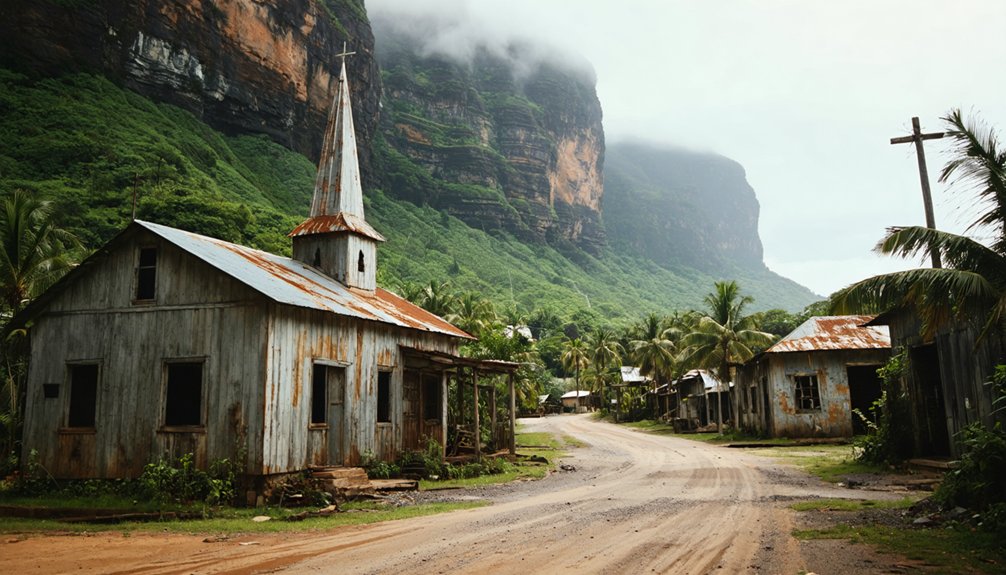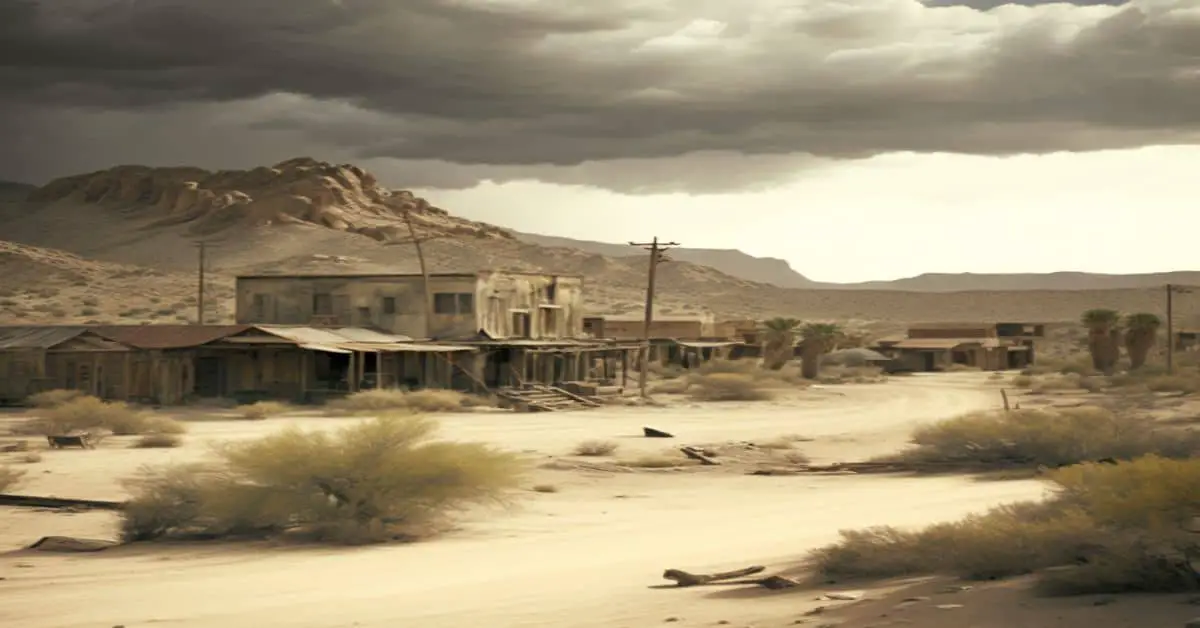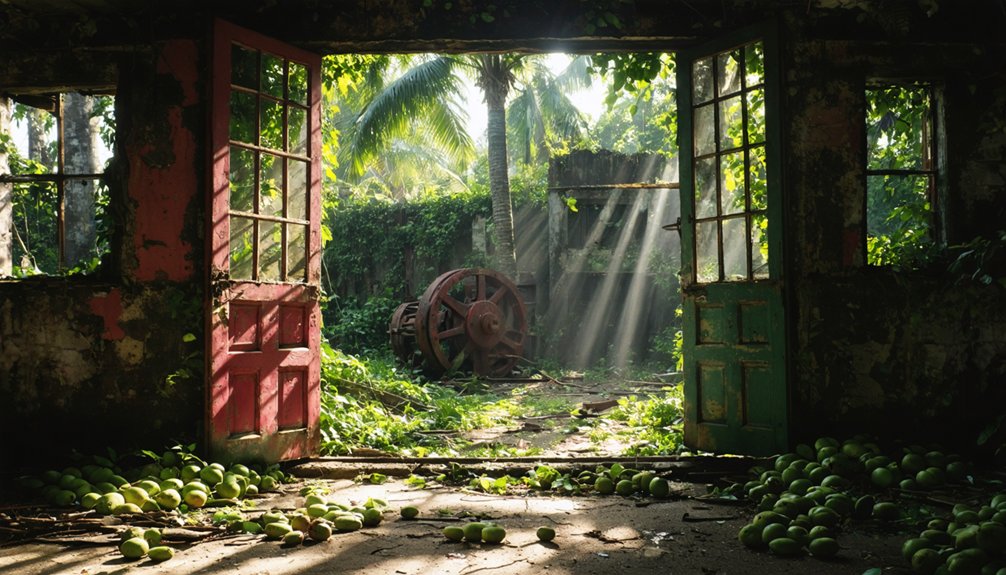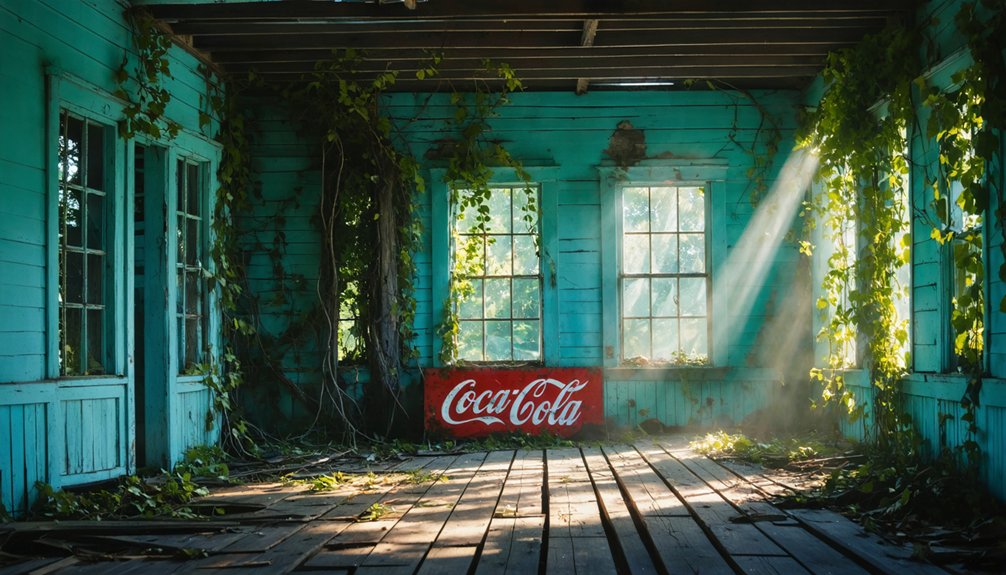Along the isolated shores of Molokai, you’ll discover Kalaupapa, a sacred ghost town with deep spiritual roots. Once a thriving ancient Hawaiian settlement, it became a Hansen’s disease colony in 1866 where over 8,000 souls were exiled. Father Damien’s compassionate leadership transformed hardship into a resilient community bound by aloha. Today, this National Historical Park protects the mana of those who found strength in unity. Their untold stories echo through the towering sea cliffs.
Key Takeaways
- Kalaupapa is a former Hansen’s disease colony on Molokai island, now nearly abandoned with only a handful of elderly residents remaining.
- The settlement’s population dropped dramatically from 5,800 to fewer than 20 people after isolation laws ended in 1969.
- Geographic isolation persists through 3,000-foot sea cliffs, with access limited to mule trails and a small airstrip.
- Historic structures, including Father Damien’s St. Philomena Church and ancient Hawaiian sites, remain preserved in the ghost town.
- The area is now a National Historical Park, commemorating over 8,000 individuals who were exiled there during its colony period.
The Rise of Hawaii’s Most Isolated Settlement
Long before Kalaupapa became known as a place of isolation, our ancestors thrived on this sacred peninsula for over 900 years.
You’ll find their legacy in the ancient stone walls, irrigated taro fields, and sacred heiau that still stand as evidence of their ingenuity and cultural heritage.
Our people built thriving communities of up to 2,700 residents, mastering both wetland and dryland farming while harvesting the ocean’s bounty.
Ancient Hawaiian settlers created prosperous villages, skillfully balancing land cultivation with ocean fishing to sustain thousands.
The historical significance of these settlements shows in every corner of the peninsula, from the intricate irrigation systems to the traditional house sites dating back to 1200 AD.
But when foreign diseases arrived in the 1800s, they devastated our population.
The establishment of a leper colony in 1866 forever changed the peninsula’s destiny.
Today, this 10,779-acre national park preserves the cultural and physical remnants of these historic settlements.
Father Damien’s Legacy and Community Life
When Father Damien arrived at our shores in 1873, he brought more than just his Catholic faith – he carried a profound dedication that would transform our isolated settlement into a true community.
Through his hands, our people learned to build homes, churches, and roads. He taught us farming and carpentry, giving us the power to sustain ourselves despite our exile. King Kalākaua recognized his extraordinary service by naming him Knight Commander of the Royal Order.
You’ll still feel his spirit in every corner of Kalaupapa. He dressed our wounds without fear, lived as our equal, and showed us we weren’t forgotten. His compassion touched many lives, including Native Hawaiian families who still remember his selfless service.
Even after contracting Hansen’s disease himself, he never stopped building our community until his last breath in 1889. His legacy lives on in our annual celebrations, in St. Philomena Church’s walls, and in our hearts as we continue to honor his sacrifice.
Natural Barriers and Geographic Isolation
Our ancestors tell stories of how Molokai’s mighty sea cliffs rose from the ocean like giant guardians, reaching heights of 3,000 feet into the heavens.
When the ancient volcano Pu’u’uao erupted beneath the sea, its pāhoehoe lava created the sacred peninsula of Kalaupapa.
Then came the great collapse, when the northern face of our island crashed into the ocean, forming these imposing cliff formations that stand watch today.
You’ll find no roads connecting Kalaupapa to the rest of Molokai – only a challenging mule trail and small airstrip breach these natural walls.
The strong trade winds and winter swells further protect our isolated shores.
These access challenges, which once served to confine those afflicted with Hansen’s disease, remind us of nature’s power to both isolate and shelter our sacred lands.
The mystical Kauhakō Crater lake provides fresh water to this remote peninsula, sustaining life in this isolated realm.
From Bustling Colony to Ghost Town
In 1865, as our ancestors faced the devastating spread of Hansen’s disease, the Hawaiian Kingdom established Kalaupapa as an isolation colony on Molokai’s sacred peninsula.
Our people endured cultural displacement, forced from their ancestral lands while thousands afflicted with the disease were banished to this remote shore.
You’d hardly recognize Kalaupapa today. What was once a bustling community of over 5,800 souls has faded into silence.
Medical advancements in the 1940s brought hope through sulfone treatments, and by 1969, the mandate for isolation finally ended.
After decades of isolation, medical science finally unlocked freedom for Kalaupapa’s residents through life-changing sulfone treatments.
Many of our brothers and sisters chose to return home, while others, bound by decades of shared experience, remained.
Now, only a handful of elderly residents walk these quiet streets, keeping alive the memories of those who lived, loved, and endured in this sacred place.
Preserving Stories of Strength and Survival
The sacred stories of Kalaupapa’s people live on through the voices of those who survived unimaginable hardship.
Though stripped of their families and homes, they found healing through shared resilience, transforming their exile into a vibrant community of mutual care and spiritual strength.
You’ll hear how they turned a barren peninsula into fertile ground, growing taro and raising livestock to sustain themselves.
Through prayer and compassion, they forged bonds stronger than the chains of isolation that bound them. Their spiritual journey transformed what outsiders called “devil’s island” into a “gateway to heaven.” Close prolonged contact was required to transmit the disease, making the forced separation policy especially tragic.
Today, their legacy echoes in every building, every tree they planted, and every story passed down.
Over 8,000 individuals were exiled to this remote settlement during its 103-year history.
The National Historical Park stands as a tribute to their triumph over stigma and suffering.
Frequently Asked Questions
How Do Residents Today Receive Medical Care and Supplies in Kalaupapa?
You’ll receive free extensive care through telehealth services and regular supply deliveries, including wound care supplies, medical devices, and medicines – all managed by DOH’s dedicated health program for residents.
Are There Any Descendants of Original Patients Still Living in Kalaupapa?
While descendants share family connections through cultural work and descendant stories, they don’t permanently reside in Kalaupapa today. You’ll find them visiting, preserving memories, and participating in community decisions.
What Modern Amenities and Utilities Are Available to Current Kalaupapa Residents?
You’ll find basic modern infrastructure – electricity for essentials, running water, phones, and slow internet. But utility challenges mean you’re living simply, adapting to limited power and spotty communications like our ancestors.
Can Visitors Stay Overnight in Kalaupapa, and Where Do They Stay?
You can’t stay overnight in Kalaupapa unless you’re a guest of current residents. For your visit, you’ll need to find overnight accommodations elsewhere on Moloka’i and make guided day trips.
How Do Current Residents Maintain Social Connections With the Outside World?
You’ll find residents connecting through limited social media, ham radio networks, and community outreach programs. They honor ancestral traditions through cultural gatherings while sharing stories with visiting family and support organizations.
References
- https://www.dark-tourism.com/index.php/761-kalaupapa-molokai-hawaii
- https://guinnessworldrecords.com/world-records/775512-largest-medical-ghost-town
- https://www.youtube.com/watch?v=QfUJyIYViNk
- https://travelingcanucks.com/2013/06/this-is-not-a-democracy-its-a-dictatorship/
- https://www.nps.gov/kala/learn/historyculture/a-brief-history-of-kalaupapa.htm
- https://magazine.byu.edu/article/the-island-of-the-forgotten/
- https://en.wikipedia.org/wiki/Kalaupapa
- https://www.nps.gov/articles/000/kalaupapa-kalawao-settlements-975012.htm
- https://www.youtube.com/watch?v=W9e5Un7VLUg
- https://en.wikipedia.org/wiki/Kalaupapa_National_Historical_Park



